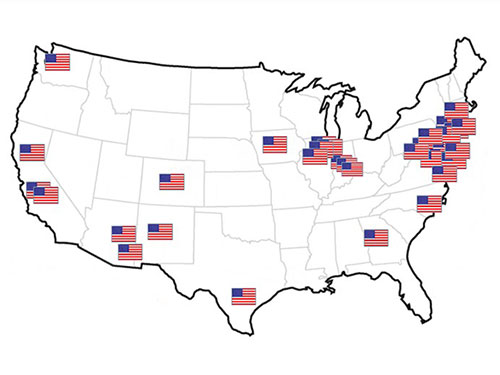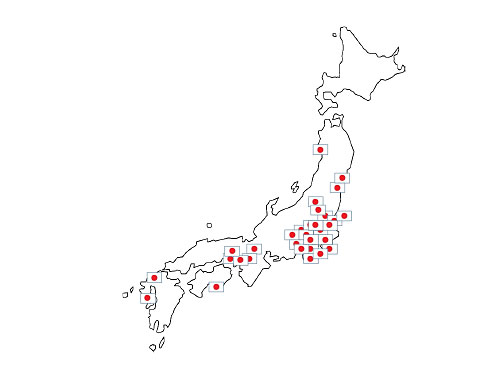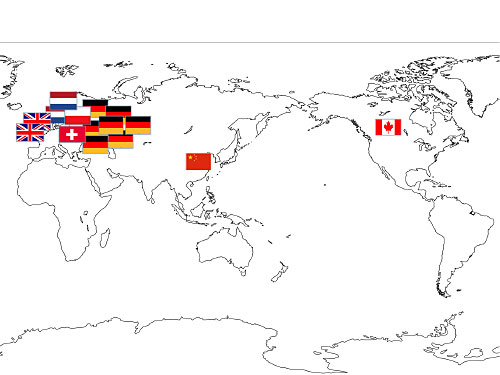 RIKEN BNL Research Center
RIKEN BNL Research Center

RIKEN BNL Research Center Alumni
RBRC graduates have received tenured positions worldwide
Alumni Spotlights
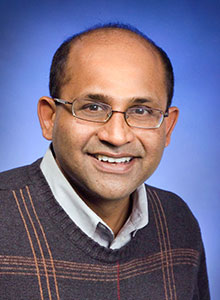
Raju Venugopalan
After earning his Ph.D. from Stony Brook University in 1992,
Venugopalan worked at several universities in the U.S. and at the Niels
Bohr Institute in Copenhagen, Denmark, before joining Brookhaven
National Laboratory in
1998. He was a Fellow of the RIKEN-BNL Research Center from 2000 to
2003, and he is currently a senior scientist in the Physics Department.
In 2004 he received a U.S. Research Fellow Award from the Humboldt
Foundation in Germany.
Dr. Venugopalan's interests are primarily in QCD, with a focus on the
theory at high energies, where quarks and gluons display novel
interesting collective many-body behavior; one example is the strongly
interacting quark gluon plasma (QGP) produced in heavy ion collisions at
RHIC and at the LHC and in how quantum states that generate this matter
look like in nuclear wave functions--their properties can be described
as a Color Glass Condensate (CGC). When two CGCs collide, they shatter
to form a highly non-equilibrium Glasma state. In strong analogy with
inflationary dynamics in the early universe, quantum fluctuations play
an essential role in thermalizing quark-gluon matter and in generating
long range rapidity correlations. Remarkably, experiments at RHIC and
LHC are able to extract finger prints of such dynamics, providing
insight into how strong color fields thermalize into the QGP. The CGC
can also be probed directly in deuteron-gold collisions at RHIC and in
p+A collisions at the LHC. Further precision studies in the future are
feasible with an Electron-Ion Collider (EIC). With on-going discoveries
at RHIC and the LHC, and active plans for future facilities, the study
of collective phenomena in QCD (the most perfect theory known) is a
vibrant sub-field of physics.
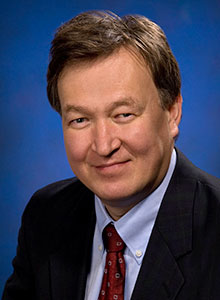
Dmitri Kharzeev
Kharzeev earned a Ph.D. in physics from Moscow State University in
1990, and after working as a research associate at the Italian Institute
of Nuclear Physics and at CERN, the European Organization for Nuclear
Research, he joined Brookhaven National Laboratory in 1997 as a Fellow of the RIKEN BNL
Research Center. He was appointed an associate scientist at Brookhaven
in 1999 and rose through the ranks to become a senior physicist in 2006,
the same year he became a Fellow of the American Physical Society. He
led Brookhaven's Nuclear Theory Group from 2004 to 2010. Kharzeev
is also a professor at Stony Brook University.
Working with data from heavy ion collisions at Brookhaven’s
world-class accelerator, the Relativistic Heavy Ion Collider (RHIC),
Kharzeev has focused his theoretical research on understanding the
properties of quark-gluon plasma, the type of matter that is thought to
have existed at the first millionth of a second after the Big Bang.
Currently, he is connecting the physics of RHIC to cosmology in his
investigation of the role of fundamental symmetries in the structure of
the universe.
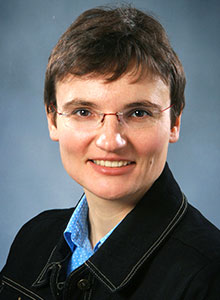
Anna Stasto
Stasto earned a master’s degree in physics at Jagiellonian University
in Poland in 1996 and a joint Ph.D. in theoretical physics at the Polish
Academy of Science and the University of Durham in the United Kingdom in
1999. After working as a postdoctoral fellow at the University of Florence,
Italy, and DESY, a national center for photon science and particle
physics research in Hamburg, Germany, Stasto joined Brookhaven National
Laboratory as a research
associate in the Physics Department in 2006. In 2008, she became
Assistant Professor in the Department of Physics at Pennsylvania State
University, while retaining a joint RIKEN BNL position BNL. She was a 2009 recipient of DOE’s Outstanding Junior
Investigator Award for her research in nuclear physics.
Stasto’s research focuses on quantum chromodynamics, a theory that
describes the interactions of subatomic particles. In particular, Stasto
investigates the properties of the strong interactions of these
particles at the limit of high energies and densities. When two strongly
interacting particles, such as hadrons, or nuclei at high energy,
collide, theorists expect a high number of partons – the building blocks
of hadrons – to be involved.
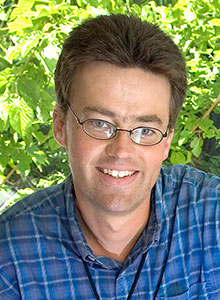
Werner Vogelsang
Vogelsang earned his Ph.D. from the University of Dortmund, Germany,
in 1993 and then took a postdoctoral position in the Theory Group at
the Rutherford Appleton Laboratory in England. In 1997 he became a
Fellow at CERN in Geneva, Switzerland, and, in 1999 he came to the U.S.
to join the C.N. Yang Institute for Theoretical Physics at Stony Brook
University. He became a RIKEN Fellow at the RIKEN BNL
Research Center in 2000.He advanced to a tenured physicist
in 2005. In 2007, he received the Friedrich Wilhelm Bessel Research
Award from the Humboldt Foundation for his outstanding research in
theoretical physics.
While at Brookhaven, Vogelsang made calculations based on quantum
chromodynamics, or QCD, a physics theory that describes the interactions
of subatomic particles called quarks and gluons. Vogelsang compared his
results with experimental data to understand how protons, which are made
of quarks and gluons, get their spin. Like other researchers, he found
that the spin of quarks accounts for only about 25 percent of proton
spin. In more recent work at RHIC, data combined with Vogelsang's
calculations so far do not show any evidence of sizable contributions of
gluon spin to the proton’s spin. More extensive and detailed studies,
both experimentally and theoretically, are needed to determine how the
proton’s spin is carried by its inner constituents.
`

Raju Venugopalan
After earning his Ph.D. from Stony Brook University in 1992, Venugopalan worked at several universities in the U.S. and at the Niels Bohr Institute in Copenhagen, Denmark, before joining Brookhaven National Laboratory in 1998. He was a Fellow of the RIKEN-BNL Research Center from 2000 to 2003, and he is currently a senior scientist in the Physics Department. In 2004 he received a U.S. Research Fellow Award from the Humboldt Foundation in Germany.
Dr. Venugopalan's interests are primarily in QCD, with a focus on the theory at high energies, where quarks and gluons display novel interesting collective many-body behavior; one example is the strongly interacting quark gluon plasma (QGP) produced in heavy ion collisions at RHIC and at the LHC and in how quantum states that generate this matter look like in nuclear wave functions--their properties can be described as a Color Glass Condensate (CGC). When two CGCs collide, they shatter to form a highly non-equilibrium Glasma state. In strong analogy with inflationary dynamics in the early universe, quantum fluctuations play an essential role in thermalizing quark-gluon matter and in generating long range rapidity correlations. Remarkably, experiments at RHIC and LHC are able to extract finger prints of such dynamics, providing insight into how strong color fields thermalize into the QGP. The CGC can also be probed directly in deuteron-gold collisions at RHIC and in p+A collisions at the LHC. Further precision studies in the future are feasible with an Electron-Ion Collider (EIC). With on-going discoveries at RHIC and the LHC, and active plans for future facilities, the study of collective phenomena in QCD (the most perfect theory known) is a vibrant sub-field of physics.

Dmitri Kharzeev
Kharzeev earned a Ph.D. in physics from Moscow State University in 1990, and after working as a research associate at the Italian Institute of Nuclear Physics and at CERN, the European Organization for Nuclear Research, he joined Brookhaven National Laboratory in 1997 as a Fellow of the RIKEN BNL Research Center. He was appointed an associate scientist at Brookhaven in 1999 and rose through the ranks to become a senior physicist in 2006, the same year he became a Fellow of the American Physical Society. He led Brookhaven's Nuclear Theory Group from 2004 to 2010. Kharzeev is also a professor at Stony Brook University.
Working with data from heavy ion collisions at Brookhaven’s world-class accelerator, the Relativistic Heavy Ion Collider (RHIC), Kharzeev has focused his theoretical research on understanding the properties of quark-gluon plasma, the type of matter that is thought to have existed at the first millionth of a second after the Big Bang. Currently, he is connecting the physics of RHIC to cosmology in his investigation of the role of fundamental symmetries in the structure of the universe.

Anna Stasto
Stasto earned a master’s degree in physics at Jagiellonian University in Poland in 1996 and a joint Ph.D. in theoretical physics at the Polish Academy of Science and the University of Durham in the United Kingdom in 1999. After working as a postdoctoral fellow at the University of Florence, Italy, and DESY, a national center for photon science and particle physics research in Hamburg, Germany, Stasto joined Brookhaven National Laboratory as a research associate in the Physics Department in 2006. In 2008, she became Assistant Professor in the Department of Physics at Pennsylvania State University, while retaining a joint RIKEN BNL position BNL. She was a 2009 recipient of DOE’s Outstanding Junior Investigator Award for her research in nuclear physics.
Stasto’s research focuses on quantum chromodynamics, a theory that describes the interactions of subatomic particles. In particular, Stasto investigates the properties of the strong interactions of these particles at the limit of high energies and densities. When two strongly interacting particles, such as hadrons, or nuclei at high energy, collide, theorists expect a high number of partons – the building blocks of hadrons – to be involved.

Werner Vogelsang
Vogelsang earned his Ph.D. from the University of Dortmund, Germany, in 1993 and then took a postdoctoral position in the Theory Group at the Rutherford Appleton Laboratory in England. In 1997 he became a Fellow at CERN in Geneva, Switzerland, and, in 1999 he came to the U.S. to join the C.N. Yang Institute for Theoretical Physics at Stony Brook University. He became a RIKEN Fellow at the RIKEN BNL Research Center in 2000.He advanced to a tenured physicist in 2005. In 2007, he received the Friedrich Wilhelm Bessel Research Award from the Humboldt Foundation for his outstanding research in theoretical physics.
While at Brookhaven, Vogelsang made calculations based on quantum chromodynamics, or QCD, a physics theory that describes the interactions of subatomic particles called quarks and gluons. Vogelsang compared his results with experimental data to understand how protons, which are made of quarks and gluons, get their spin. Like other researchers, he found that the spin of quarks accounts for only about 25 percent of proton spin. In more recent work at RHIC, data combined with Vogelsang's calculations so far do not show any evidence of sizable contributions of gluon spin to the proton’s spin. More extensive and detailed studies, both experimentally and theoretically, are needed to determine how the proton’s spin is carried by its inner constituents.
